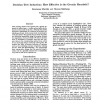Free Online Productivity Tools
i2Speak
i2Symbol
i2OCR
iTex2Img
iWeb2Print
iWeb2Shot
i2Type
iPdf2Split
iPdf2Merge
i2Bopomofo
i2Arabic
i2Style
i2Image
i2PDF
iLatex2Rtf
Sci2ools
KDD
1995
ACM
1995
ACM
Decision Tree Induction: How Effective is the Greedy Heuristic?
Mostexisting decision tree systemsuse a greedyapproachto inducetrees -- locally optimalsplits are inducedat every node of the tree. Althoughthe greedy approachis suboptimal,it is believed to producereasonablygoodtrees. In the current work,weattempt to verify this belief. Wequantify the goodnessof greedy tree induction empirically, using the populardecision tree algorithms, C4.5 and CART.Weinduce decision trees on thousands of synthetic data sets and compare themto the correspondingoptimal trees, which in turn are foundusing a novel mapcoloring idea. We measurethe effect on greedy induction of variables such as the underlying concept complexity, training set size, noise and dimensionality. Ourexperiments show,amongother things, that the expectedclassification cost of a greedily inducedtree is consistently very close to that of the optimaltree.
| Added | 26 Aug 2010 |
| Updated | 26 Aug 2010 |
| Type | Conference |
| Year | 1995 |
| Where | KDD |
| Authors | Sreerama K. Murthy, Steven Salzberg |
Comments (0)

